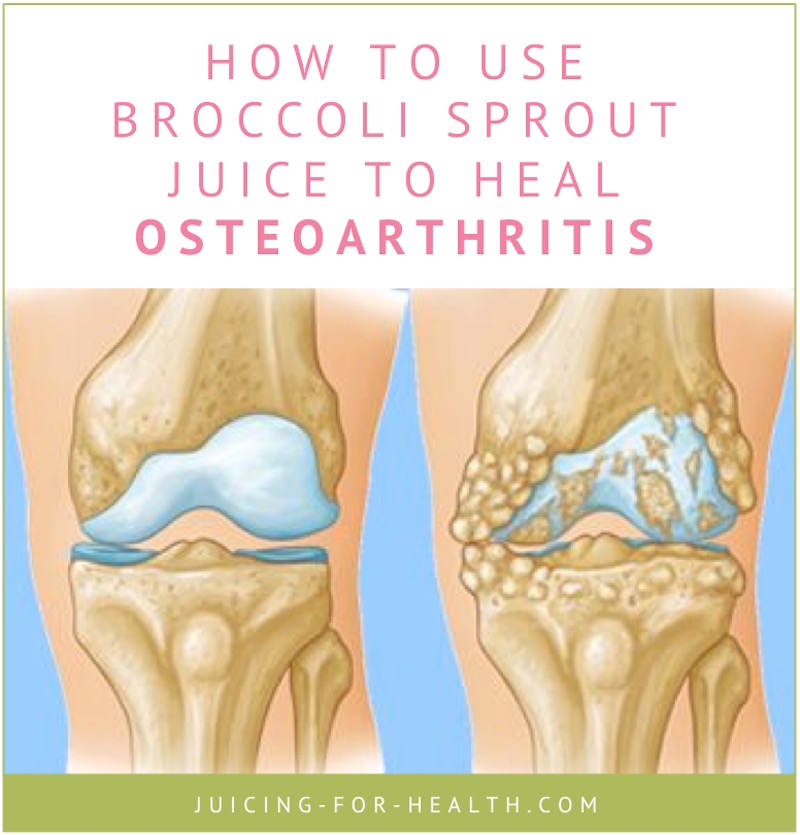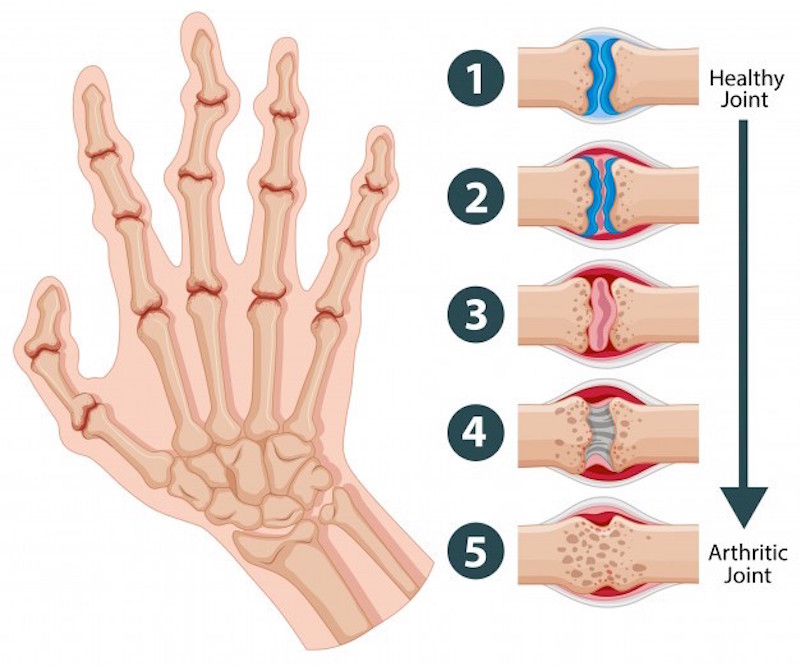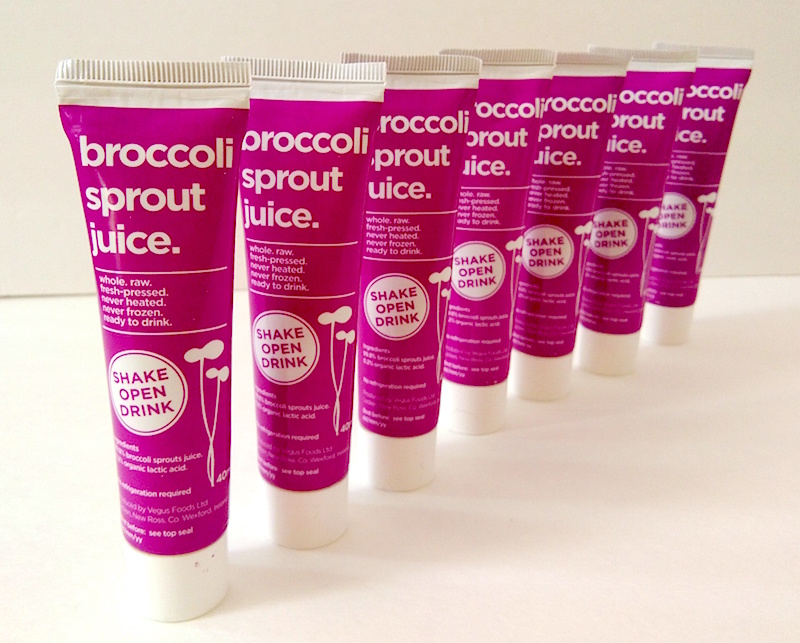How To Use Sulforaphane To Heal Rheumatoid And Osteoarthritis Joints
Last updated on
Arthritis is the general term for more than 100 different types of inflammation of the joints. The most common of them are rheumatoid arthritis (RA) and osteoarthritis. Both these conditions have a tremendous impact on the life of millions around the world.
According to the World Health Organization, up to 1% of the global population suffers from rheumatoid arthritis, and the condition is more common in developed countries.
Women are more frequently struck by RA than men. It’s estimated that more than half of RA sufferers become unable to work full-time within 10 years of the onset of rheumatoid arthritis.
Osteoarthritis is a degenerative disease of the joints’ cartilage – basically, it’s the joints wearing down with years. That’s why doing heavy manual labor, like farming, increases the risk of developing osteoarthritis by up to 9.3 times!
About 9.6% of men and up to 18% of women after 60, suffer from osteoarthritis, and up to 25% of them will become unable to perform their daily activities due to the disease.
So much for the bad news!

In this article, we will discuss an incredibly powerful natural component that fights every damaging aspect of arthritis, but first, let’s take a good look at what this disease is all about.
Arthritis – What’s Happening In Your Body?
Rheumatoid arthritis has 3 main components:
- Autoimmune damage – The body produces immune cells that start attacking the joints of your body instead of protecting them.
- Due to the autoimmune damage and the constant movements, the tissues of the joints become inflamed, swollen, and painful.
- Inflammation always leads to the building up of connective tissue in the form of scars. During arthritis, this leads to severe deformities and movement limitation.
Imagine it like this: a joint is like a little capsule covering the ends of two neighboring bones. The end of each bone is covered in smooth cartilage tissue to decrease the friction between them. The joint chamber itself is filled with slimy fluid to decrease the friction between bones.

So, without going into too much detail, arthritis is all about the cartilage on the end of your bones wearing out (osteoarthritis) or being damaged (rheumatoid arthritis).
When this happens, the bones start rubbing and scratching against each other, damaging themselves and the joint with each movement. The inflammation gets worse, the cartilage is destroyed further, and the vicious cycle repeats itself.
Now, on to the good news!
Sulforaphane – The Cure For Joint Damage In Rheumatoid And Osteoarthritis
Sulforaphane is a compound that’s formed in all plants of the cruciferous family (mustard, cauliflower, broccoli, cabbage, Brussels sprouts) when they are cut or damaged in any way.
When the cells of these vegetables are broken down in the process of cutting, chopping, chewing, or juicing, the enzyme myrosinase reacts with glucoraphanin – and sulforaphane is the beautiful result of this reaction.
What Makes Sulforaphane So Great For Your Joints?
Well, there are nutrients that are just healthy, and there are nutrients that are borderline miraculous. Sulforaphane is borderline miraculous.
It fights cancer, reverses autism, soothes inflammation, kills the bacteria that cause peptic ulcers, and the list of benefits goes on and on.
Today we’re going to focus on one more facet of sulforaphane’s healing power: it has cartilage-protective (chondroprotective) agents that protect and heal rheumatoid arthritis joints.
Remember the three components of RA listed above? Here’s how sulforaphane helps to deal with each of them:
Reduces autoimmune damage: Studies indicate that sulforaphane inhibits the production of immune factors (interleukins, prostaglandins, etc.) that essentially cause the immune damage to the joints. It also protects the cartilage from any inflammatory damage that may be currently taking place.
Soothes inflammation: Animal studies confirm that sulforaphane effectively reduces joint inflammation on a molecular and immune level. Another great effect is that it protects the non-inflamed joint cells, making the inflammation less likely to spread.
Prevents scarring: Along with healing inflammation, sulforaphane also fights the consequences of rheumatoid arthritis by inhibiting the proliferation of fibroblasts (cells that produce scar tissue) inside the joints.
Bonus: It helps osteoarthritis as well!
When compared with RA, osteoarthritis is less about the autoimmune component and more about the cartilage destruction. Well, guess what?
Studies have confirmed in various osteoarthritis models that sulforaphane significantly reduces the destruction of joints by blocking key molecular pathways involved in the condition!
It also helps to strengthen the bones and prevent gait anomalies that may result from osteoarthritis.
How Can You Get More Of Sulforaphane?
Every cruciferous vegetable is a good source of sulforaphane, so make sure to include a lot of them to your diet: cabbage, broccoli, cauliflower, everything counts. Raw is best as you need the enzyme myrosinase to react with glucoraphanin to produce sulforaphane. Heat destroys live enzymes.
I get it, that it is impossible to eat enough sulforaphane daily for the purpose of healing arthritis. That is why drinking freshly-extracted juices is the next best thing. Still, how do you get sufficient sulforaphane without getting sick of cruciferous vegetables?

Broccoli sprout juice. According to studies, 3 to 5-day old broccoli sprouts have 10-100 times more glucoraphanin (the precursor of sulforaphane) than mature broccoli. This means that in terms of sulforaphane, having just one ounce of broccoli sprouts would be like eating 1.5 pounds of broccoli!
Just take a bunch of broccoli sprouts, combine them with your favorite greens, juice away and get healthy!
How Does Sulforaphane Heal Joints So Effectively?
Conventional Treatment of Severe Arthritis
Did you know that the conventional treatment of severe arthritis includes steroids being injected directly into the joints? This is done to ensure that the medication is delivered to the inflammation site as effectively as possible, because it can be really hard to get inside the joint.
Sounds reasonable, but the side effects are huge as well.
Worse, it doesn’t heal you. It just relieves your pain temporarily, while fooling your brain that you’re fine. Then every two or three months you will need another injection. Just google “corticosteroids side effects” and you will not want to go down that route!
How Sulforaphane Heals Your Joints
Now here’s an alternative to consider: Studies indicate that after you consume high glucosinolate broccoli, sulforaphane is detected inside your joints. Effective natural healing, delivered where your body needs it, without any painful and harmful injections whatsoever.
Although broccoli has been found to contain the highest amount of glucoraphanin, there are different varieties of broccoli and not all broccoli will give you the same results.
Some varieties of broccoli have very little glucoraphanin, so you could be eating tons of broccoli sprouts yet you don’t get the optimum amount of sulforaphane. Getting a high glucoraphanin content variety of broccoli that is non-GMO is especially important.
How To Consume Sulforaphane To Heal Arthritis Joints
We have ascertained that 3 to 5-day old broccoli sprouts (baby shoots of broccoli) will give you the most glucoraphanin content to convert into sulforaphane. Enzyme myrosinase has to be present at the same time of consuming glucoraphanin-containing foods for conversion of sulforaphane. This is why extracts of glucoraphanin often don’t work as well.
How broccoli sprouts are prepared is highly important in obtaining maximum sulforaphane so you consume less for more.
There are ways to get your broccoli sprouts supply—you can either grow your own or purchase high quality sulforaphane-packed broccoli sprout juice ready to drink if you prefer convenience or don’t have the time to wait.
Independent laboratories tested Vegus Foods’ Broccoli Sprout Juice to contain at least 25 micromoles of isothiocyanates including sulforaphane per 10 ml, which means one 40ml tube contains a huge 100 micromoles isothiocyanates including sulforaphane.

Go here to learn more about getting
high quality sulforaphane broccoli sprout juice >>
Your take home message today: There’s a healthy answer to almost any disease in this world. In the case of rheumatoid arthritis and osteoarthritis, sulforaphane is your best shot!
Some of the links I post on this site are affiliate links. If you go through them to make a purchase, I will earn a small commission (at no additional cost to you). However, note that I’m recommending these products because of their quality and that I have good experience using them, not because of the commission to be made.
Comments
Leave a Reply

































 JOIN OVER
JOIN OVER
Finding comfort in all your recent posting. Thank you so very much.
I would like to know more about getting help for arthritis I have so much pain in my knees